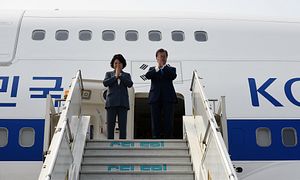South Korean President Moon Jae-in was in India this week on a four-day state visit, after which he moved on to Singapore. The visits put a focus on South Korea’s foreign policy development under Moon and its efforts to strengthen ties with regional states.
The visits have been cast as part of Moon’s New Southern Policy, focused on India and ASEAN. Part of the rationale in this policy is that Moon is trying to diversify South Korea’s relations, particularly with significant countries in the region, beyond just China. In the backdrop of some strains in the bilateral relationship between Seoul and Beijing, there are some within South Korea who endorse this changed approach in its foreign and strategic engagements and consider it as “a timely, even necessary, development.”
Considering the larger geopolitical developments underway in the Indo-Pacific, the expectation might have been that both Moon and Prime Minister Narendra Modi would have tried to drive the bilateral relationship from an economic and trade to a security and strategic perspective.
But a look at the bilateral engagements and agreements signed by the two sides shows that economic and commercial ties still dominate this relationship. The two sides signed 11 agreements including on Internet of Things (IoT), Artificial Intelligence (AI), Big Data, and anti-dumping.
To be sure, South Korea has long played a key role in India’s economic growth story since the early 1990s, when India liberalized its economy and opened its market. But at the same time, while trade and economic ties are important to give substance to the partnership, the two sides should not lose sight of the strategic imperative that are forcing critical shifts in their foreign policies and there are immense possibilities for the future.
During the visit, Moon and Modi announced a shared vision for building a new era of India-Korea Special Strategic Partnership, a reference to the tag that the relationship was elevated to during Modi’s visit to Seoul in 2015.
The vision spells out a number of initiatives in the foreign policy and strategic realm, reflecting the regional anxieties and tensions and a shared approach to addressing these. The two leaders have, for instance, emphasized freedom of navigation, overflight, and unimpeded lawful commerce; resolving disputes on the basis of sovereignty, territorial integrity, and international law; as well as contending with the proliferation of weapons of mass destruction, which is a shared priority. They also pledged to strengthen various elements of military-to-military cooperation as well through areas like training, exchanges, and research and development.
To be sure, that shared vision does not mean South Korea and India are entirely aligned across the board on issues. South Korea so far has not been part of initiatives such as the so-called “Quad” or even other related minilaterals, in part because its own approach to China is a more complex and ambivalent one.
Nonetheless, there have been clear efforts by the Moon government to cultivate ties with other regional states such as India, whether as part of a diversification strategy or to make further inroads with respect to new strategic partners and markets. Recent incidents, including accusations of China flying military aircraft into the Korean air defense identification zone without providing prior notification and China’s combative reactions to the South Korean decision to deploy a U.S. Terminal High Altitude Area Defense (THAAD) system in South Korea, have shaken Seoul’s confidence in Beijing. Even as relations between Seoul and Beijing have shown signs of warming up, South Korea’s quest for a broader foreign policy approach along with the need for newer markets are visible in Moon’s outreach.
Within this context, trade is still likely to be critical in the India-South Korea relationship. Especially after its business was hit hard last year following China’s reactions to South Korea’s THAAD decision, Seoul is looking to diversify its economic presence and India offers plentiful opportunities in this regard. The large export market, in addition to providing infrastructural development support, can push the India-South Korea economic relations to newer heights. In 2015, during Modi’s visit, the two sides had signed a Framework of Cooperation in the areas of road transportation and highways and another MoU in maritime transport and logistics. The two sides are also eyeing development and infrastructure projects in third countries such as in Afghanistan.
One other area where new cooperation could emerge is in defense technology. South Korea’s expertise in developing high-end defense electronics should be of particular interest to India. One of the agreements signed during the visit pertains to defense industry collaboration, and India last year signed an agreement for the development of artillery guns under the Make in India initiative. To be sure, there are obstacles: as an example, India’s plans to collaborate with South Korea for the co-production of the 12 minesweepers for the Indian Navy fell apart earlier this year due to cost and transfer of technology issues. But there definitely potential here for closer cooperation, as there is in the India-South Korea relationship more broadly.
































